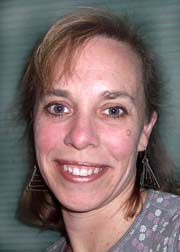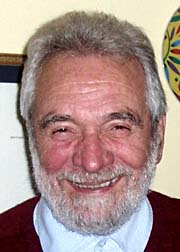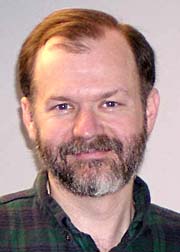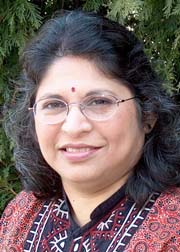Registration
Click here to register on-line, and pay by credit card (deadline 5 pm, March 17th).
Click here to register by mail, and pay by check (deadline March 16th).
Spring 2009 SoCal-Nev Section Meeting
California Lutheran University
Thousand Oaks, CA
Saturday, March 21, 2009
Tentative Program
- 8:00-12:00 Registration
Preus-Brandt Forum Lobby - 8:15-10:30 Refreshments
Preus-Brandt Forum Foyer
- 8:30-2:30 MAA Book Sale
Preus-Brandt Forum Foyer
Organized by Richard Katz and Michael Hoffman, Cal State Los Angeles - 9:00-10:00 Invited Address by Annalisa Crannell, Franklin and Marshall College
Math and Art: The Good, the Bad, and the Pretty
Preus-Brandt Forum Theater - 10:00-10:15 Section Business Meeting
Presentation of Section Distinguished Teaching Award
Recognition of 25 and 50-year MAA members
Preus-Brandt Forum Theater - 10:05-11:55 Section NExT Session--Open to all meeting participants
Mathematical Ideas: a different approach to teaching math - 10:15-11:15 Student Poster Sessions
Falde Plaza
Organized by Cynthia Wyels, CSUCI - Call for Judges for the Student Poster Contest
Please consider donating 20 - 30 minutes of the Student Poster Contest to judging. We need about 30 judges to distribute the load well. Sign up by filling out the very brief survey here. - 11:15-12:15 Invited Address by Mario Martelli, Claremont Graduate University
Chaos in the Solar System
Preus-Brandt Forum Theater - 12:15-1:30 Luncheon
Pepper Grove Lawn (East of Falde Plaza) - 1:30-2:30 Invited Address by Robert Lang, www.langorigami.com
From Flapping Birds to Space Telescopes: The Modern Science of Origami
Preus-Brandt Forum Theater - 2:30-3:00 Refreshments
Preus-Brandt Forum Foyer
- 3:00-5:30 Open to all attendees: Section NExT Sponsored Workshop by Aparna Higgins, University of Dayton
Undergraduate Research: an Introduction to Our Profession
Preus-Brandt Forum Theater
Directions and Maps
California Lutheran University is in Thousand Oaks, CA.
For directions, see
www.callutheran.edu/neighbors/guide/directions_to.php.
For a map, see
www.callutheran.edu/directory/map.php
Meeting parking is free in the parking lot at the corner of Olsen Road and Mountclef Boulevard. Enter off of Mountclef Boulevard.
Hotels
Here is a list of hotels near campus. www.callutheran.edu/neighbors/guide/where_to_stay.phpRegisteration coming soon...
Click here to register on-line, and pay by credit card (deadline 5 pm, March 17th).
Click here to register by mail, and pay by check (deadline March 16th).
Registration Fees
| Registration | |
| Nonmember | $35 |
| MAA Member | $30 |
| Student | $12 |
| Registration and Luncheon | |
| Nonmember | $50 |
| MAA Member | $45 |
| Student | $20 |
On-site registration will be available for the meeting, but will be $5 more than the pre-registration charge.
Register on-line
Click here to access on-line registration, and pay by credit card.
Register by mail
Click here for a pdf of the preregistration form. Trouble viewing the pdf?
Annalisa CrannellFranklin and Marshal College
|
Annalisa Crannell is a Professor of Mathematics at Franklin & Marshall College and Governor of the MAA-EPADEL section. Her primary research is in topological dynamical systems (also known as "Chaos Theory"), but she also is active in developing materials for courses on Mathematics and Art. She has worked extensively with students and other teachers on writing in mathematics, and with recent doctorates on employment in mathematics. She especially enjoys talking to non-mathematicians who haven't (yet) learned where the most beautiful aspects of the subject lie. |
Math and Art: The Good, the Bad, and the Pretty
Back by popular demand! Dust off those old similar triangles, and get ready to put them to new use in looking at art! We're going to explore the mathematics behind perspective paintings---a mathematics that starts off with simple rules, and yet leads into really lovely, really tricky mathematical puzzles. Why do artists use vanishing points? What's the difference between 1-point and 3-point perspective? What's the difference between a perspective artist and a camera? We'll look at all of these questions, and more.
Mario MartelliClaremont GraduateUniversity 
|
Mario Martelli is Professor of Mathematics at Claremont Graduate University. Mario came to the U.S. in 1980 from a professorship at the University of Florence, in his native Italy. He became a member of the MAA Southern California Section in 1987, when he accepted a position as Professor of Mathematics at California State University, Fullerton. He was Professor of Mathematics at Claremont McKenna College from 2000 to 2008. Dr. Martelli is an expert in discrete and continuous dynamical systems and chaos theory. His current research is on global asymptotic stability, with a recent paper on the chaotic librations of Hyperion, a satellite of the planet Saturn. Dr. Martelli is well known for his leadership in promoting undergraduate research, both by successfully involving his own students in research and by providing opportunities for undergraduates from across the country to present their research at local and national MAA meetings. Several of Dr. Martelli’s students have co-authored papers with him and many more have presented posters at MAA meetings. One of his students was chosen to participate in the Poster Session for Members of the U.S. Congress organized by the Council on Undergraduate Research in Washington, DC, in April 1998. Dr. Martelli founded and directed for many years the enormously successful Student Poster Session at the Joint Mathematics Meetings, and helped found and direct a Research Experience for Undergraduates (REU) program at the Claremont Colleges. Dr. Martelli is the recipient of several awards, including the Outstanding Professor Award from California State University, Fullerton, the Distinguished Teaching Award from the MAA Southern California Section, and the MAA Meritorious Service Award for his service to the MAA Southern California-Nevada Section. He received his Ph.D. in Differential Equations from the University of Florence in 1966 and is a member of the American Mathematical Society, the Mathematical Association of America and the Italian Mathematical Union. |
Chaos in the Solar System
There are many different definitions of chaos, but no matter what choice we make, we find, in the solar system, celestial bodies that appear to oscillate chaotically. In this conversation we shall try to understand their behavior and to explain it from a mathematical point of view. Hence, our approach will not be experimental, although we will use some numerical evidence to validate our reasoning. We shall find that the orbital position of the Space Station Freedom is dangerous, although unavoidable. NASA decided to use four gyroscopes to stabilize it.
Robert Langwww.langorigami.com |
Robert J. Lang has been an avid student of origami for some forty years and is now recognized as one of the world’s leading masters of the art, with over 500 designs cataloged and diagrammed. He is noted for designs of great detail and realism, and includes in his repertoire some of the most complex origami designs ever created. His work combines aspects of the Western school of mathematical origami design with the Eastern emphasis upon line and form to yield models that are at once distinctive, elegant, and challenging to fold. Dr. Lang was the first Westerner invited to address the Nippon (Japan) Origami Association’s annual meeting (in 1992) and has been an invited guest at international origami conventions around the world. Dr. Lang is one of the pioneers of the cross-disciplinary marriage of origami with mathematics and has presented several refereed technical papers on origami mathematics at mathematical and computer science professional meetings; he also organized the Fourth International Meeting on Origami in Science, Mathematics, and Education, held at Caltech in 2006. He has consulted on applications of origami to engineering problems including medical devices, air-bag design, and expandable space telescopes. He is the author or co-author of eight books and numerous articles on origami and is a regular lecturer on the connections between origami, mathematics, science, and technology. |
From Flapping Birds to Space Telescopes:
The Modern Science of Origami
The last decade of this past century has been witness to a revolution in the development and application of mathematical techniques to origami, the centuries-old Japanese art of paper-folding. The techniques used in mathematical origami design range from the abstruse to the highly approachable. In this talk, I will describe how geometric concepts led to the solution of a broad class of origami folding problems – specifically, the problem of efficiently folding a shape with an arbitrary number and arrangement of flaps, and along the way, enabled origami designs of mind-blowing complexity and realism, some of which you’ll see, too. As often happens in mathematics, theory originally developed for its own sake has led to some surprising practical applications. The algorithms and theorems of origami design have shed light on long-standing mathematical questions and have solved practical engineering problems. I will discuss examples of how origami has enabled safer airbags, Brobdingnagian space telescopes, and more.
Aparna HigginsUniversity of Dayton(visiting CSU Channel Islands)  |
Aparna Higgins received a B.Sc. in mathematics from the University of Bombay in 1978 and a Ph.D. in mathematics from the University of Notre Dame in 1983. Her dissertation was in universal algebra, and her current research interests are in graph theory. She has taught at the University of Dayton, Ohio, since 1984. Although Aparna enjoys teaching the usual collection of undergraduate courses, her most fulfilling experiences as a teacher have come from directing undergraduates in mathematical research. She has advised twelve undergraduate Honors theses; she has co-directed an NSF-sponsored Research Experiences for Undergraduates program; and she continues to help students prepare talks for regional and national mathematics meetings. Aparna is an advocate of academic year undergraduate research at one's own institution. Aparna has been the recipient of four teaching awards -- from the College of Arts and Sciences at the University of Dayton, the Alumni Award (a University-wide award), the Ohio Section of the Mathematical Association of America, and in 2005, the Deborah and Tepper Haimo Award for Distinguished University Teaching, the MAA's most prestigious award for teaching. Aparna has served the MAA in many capacities, including being a founding member of, and then chairing, the Committee on Student Chapters. Aparna is a co-director of Project NExT (New Experiences in Teaching), a professional development program of the MAA for new or recent Ph.D.s in the mathematical sciences. Aparna Higgins is married to Bill Higgins, a mathematician who teaches at Wittenberg University, in Springfield, Ohio. They like to take year-long sabbaticals and spend part of that time teaching at other institutions. They feel privileged to have taught at the Naval Postgraduate School in Monterey, California, at the United States Military Academy in West Point, New York, and at California State University Channel Islands, where they are on sabbatical this year. Aparna and Bill Higgins have two sons. |
Undergraduate research: an introduction to our profession
This workshop is designed to provide some ideas and resources to faculty who are just beginning to engage undergraduates in research during the academic year at their own institutions. We will cover many aspects of facilitating research by undergraduates, such as getting students involved in mathematical research, finding appropriate problems, deciding how much help to provide, and presenting and publishing the results. We will emphasize the value of a research experience to the student researchers. Although the examples used in the workshop will be primarily in the area of discrete mathematics, the strategies discussed can be applied to any area of mathematics.Student Poster Session
Over 40% of those in attendance at the Fall Meeting were students, and they made their presence felt by presenting talks, asking questions in the invited lectures, and generally soaking up all there was to take advantage of. What with the Student Poster Contest at the Spring Meeting, might we have 50% students?
How about you or your students?
Both undergraduate and graduate students are invited to present a poster at the Spring Section Meeting of the MAA. Student Poster Session Registration Site
Here are some ideas of what students can present:
- Results of masters thesis, honors, senior, or independent study projects
- Results of classroom projects or modeling contests
- Results of REUs or other summer research programs
- Historical investigations in pure or applied mathematics
- Solutions of problems from the Putnam Exam or from the Monthly or other journals
